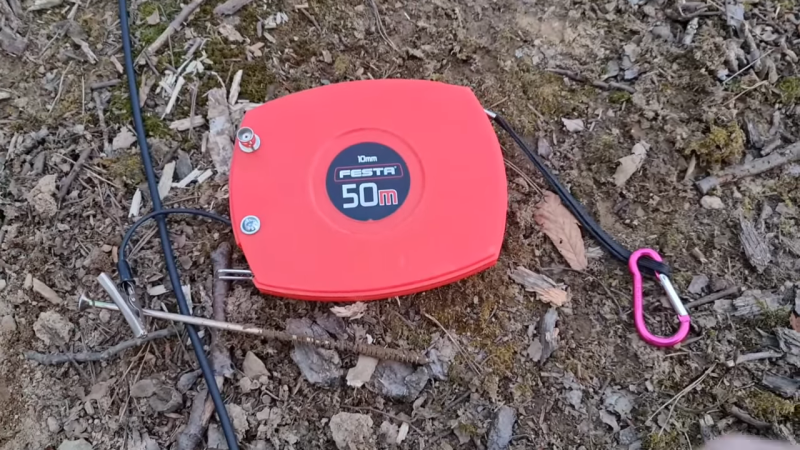If there’s one thing that amateur radio operators are good at, it’s turning just about anything into an antenna. And hams have a long history of portable operations, too, where they drag a (sometimes) minimalist setup of gear into the woods and set up shop to bag some contacts. Getting the two together, as with this field-portable antenna made from a tape measure, is a double win in any ham’s book.
For [Paul (OM0ET)], this build seems motivated mainly by the portability aspect, and less by the “will it antenna?” challenge. In keeping with that, he chose a 50-meter steel tape measure as the basis of the build. This isn’t one of those retractable tape measures, mind you — just a long strip of flexible metal on a wind-up spool in a plastic case. His idea was to use the tape as the radiator for an end-fed halfwave, or EFHW, antenna, a multiband design that’s a popular option for hams operating from the 80-m band down to the 10-m band. EFHW antennas require an impedance-matching transformer, a miniature version of which [Paul] built and tucked within the tape measure case, along with a BNC connector to connect to the radio and a flying lead to connect to the tape.
Since a half-wave antenna is half the length of the target wavelength, [Paul] cut off the last ten meters of the tape to save a little weight. He also scratched off the coating on the tape at about the 40-meter mark, to make good contact with the alligator clip on the flying lead. The first video below details the build, while the second video shows the antenna under test in the field, where it met all of the initial criteria of portability and ease of deployment.















What is a BNS connector? Perhaps he meant to say BNC.
In the video thumbnail you can see the BNC connector mounted on the upper left hand face of the tape measure’s case.
Fat-fingered it, sorry. Corrected, thanks for the heads up.
Ok it,s a spelling mistake.Grt over it.
Wow, what a cool idea, I thus have been duly stimulated to rise to the occasion and consider other conductive material erections similarly, yikes the bind moggles :D
Thanks for posting, looking for extensions to the appropriate paradigms on all things moving upwards towards increasing ones acquisition of even more energy, whether electrical or biochemical for that matter ;-)
Cheers
very big power consumption, and resistor
I love how all this hay is being made about how clever this is. It was an ancient idea when i first used it in 1979 as KB4ENK
I remember making a 2 meter whip antenna out of a junked section of tape measure soldered into a pl-259 connector about 20 years ago when I got my license as a broke as heck highschooler, it worked good enough to hit the local repeater 30 miles away.
Just a note, these were made by Hi Gain antenna in the 60’s and 70’s for the US military and civilian market. They are center fed diapoles. I have one. You can find them on eBay sometimes. I’m sure your version is much lighter than the one I have.
Collins made a nice one too. The 637-T1
Not particularly novel, my dad used one during WW2!
When I read about it years ago, a tape measure was suggested for portable units. A level of rigidity, but it bends if it hits a tree.
I heard in the Vietnam War that U.S. Radiomen used slinkys as makeshift antennas.
Circular polarization?
In woodworking no one would say anything negative about someone showing people how to make a dovetail joint despite it not being a new idea. Thanks for the videos. Radio waves – Marconi did it in 1894. Nothing to see here, everyone go home.
Just off Rte 6, (Bourne? Mattapoisett?), on the way to Cape Cod, Massachusetts, stood a Marconi tower when I was a kid. One of the first.
But heck, it was vertical. I hung discarded telephone pole wire for horizontal polarization of 27.125. 200 mW of walkie tx, by 5.5 meters wide in 1979!
I like that!
One option that he never mentions is the use of a short counterpoise, which would probably have lowered his vswr on all the bands.
Very well done. Thoroughly enjoyed watching both videos, and quite informative.
Have you tried tapping at 20m to see if it matches better on the 40m band and up?
I would recommend getting a weight (heavier than the whole antenna combined and a string to connect to the measuring tape end. It’s easier to throw and the weight hanging down could suspend the tape without getting caught in the tree. You could also wrap another string around a tree to get the antenna parallel with the horizon.
How about using a plastic coated fish tape?